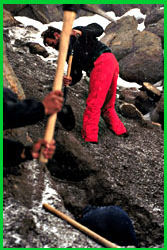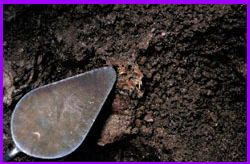 |
 |
 |
 High Altitude Archaeology
High Altitude Archaeologyby Liesl Clark The Lost Empire | The Sacrificial Ceremony | High Altitude Archaeology | Burial Artefacts Clink, clink, clink, pause. Johan Reinhard stops to take a breath, ice axe in hand, as Carlos Zarate scrapes away the dislodged debris with a shovel. The high altitude plains stretch as far as the eye can see. A few snow-capped Andean peaks in the distance rise above the cloud layer, which hovers a few thousand feet below us. This is science with a million-dollar view, otherwise known as high altitude archaeology. Most people think of archaeological excavations as the slow, painstaking wiping away of minute layers of sand and earth, usually with a small brush. At high altitude, however, time is short, because the oxygen-deprived environment is not life sustaining. Shovels and ice axes are what's needed to penetrate the frozen hard materials that mountains are made of. A small camp stove and tea kettle are also required instruments—hot water poured on frozen surfaces can speed up the digging process.  Just to get above 15,000 feet takes a certain breed of person: someone who
loves the mountains and can deal with uncomfortable conditions, including cold,
extreme weather, sleeplessness, lack of appetite, and a constant gasping for
breath. James Brundige, our soundman and a veteran of high altitude climbs,
describes being at altitude as "forcing your heart to have a mild stroke
because of the lack of oxygen."
Just to get above 15,000 feet takes a certain breed of person: someone who
loves the mountains and can deal with uncomfortable conditions, including cold,
extreme weather, sleeplessness, lack of appetite, and a constant gasping for
breath. James Brundige, our soundman and a veteran of high altitude climbs,
describes being at altitude as "forcing your heart to have a mild stroke
because of the lack of oxygen."Continue Expedition '96 | Dispatches | Mummies | Lost Worlds | Mail Resources | Site Map | Ice Mummies of the Inca Home | BBC Horizon Editor's Picks | Previous Sites | Join Us/E-mail | TV/Web Schedule About NOVA | Teachers | Site Map | Shop | Jobs | Search | To print PBS Online | NOVA Online | WGBH © | Updated November 2000 |